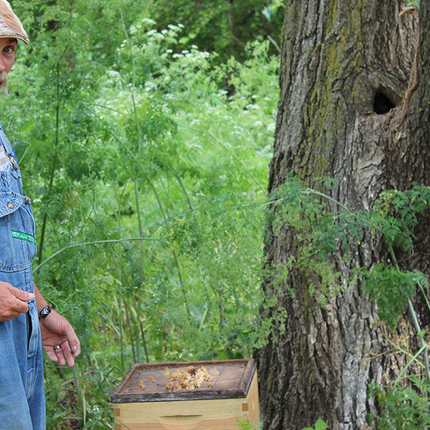Along a gravel road on the Omaha Reservation is a white house surrounded by gardens and fruit trees.
On one side of the property is an aging outhouse – the namesake of the small operation, Outhouse Honey Farm.
Bees in the outhouse
Four years ago, owner Lowell Osborne noted something peculiar.
“On the side of the outhouse, there were a whole lot of bees going in and out of that big hole,” he said. “I looked, and it was just full of bees in there.”
Lowell decided to make something of the find, and contacted a retired beekeeper. He bought a bee box and supplies at an affordable price.
This year, the hive was divided into three – one swarm of bees took to a second box and the third decided to choose their home – the side of the house.
Head gardener duties
Honey production is just one part of the Outhouse Honey Farm. Vegetables, herbs, and fruit grow almost everywhere you look. Lowell, his wife, Milissa, and their five daughters, Zena, Anabel, Zora, Olivia, and Alannah, all pitch in.
Lowell took over as head gardener three years ago.
“Originally, Lowell gardened because this was a way for him to make a little extra money,” Milissa said. “That’s why we expanded like we did.”
“I have a lot of kids to feed,” Lowell said.
The Osbornes are faithful vendors at the Omaha Reservation farmers market and the Christmas Bazaar, both run by the Center for Rural Affairs.
Expanding the garden
Suzi French, Center for Rural Affairs community foods specialist, said the Osbornes have nearly quadrupled the size of their garden from 2016 to 2017.
Among the new items are watermelon, sunflowers, lettuce, kohlrabi, turnips, green beans, spinach, eggplant, celery, Brussels sprouts, and additional pepper and cabbage plants.
Their one and only cabbage last year – Cabbage Carl – won a purple ribbon in open class competition at the county fair. Zena received the plant as part of a school project.
Most of the produce is taken to the kitchen for canning, making jellies, pickling, and to put into pies. The Osbornes are known for their cinnamon pickles which uses an “old family recipe.”
Planting a garden this size takes some planning. Milissa explained there are hot peppers and sweet peppers on either side, with tomatoes in between, preventing the sweet plants from turning hot.
She has also studied companion planting, so in the front flowerbed, garlic is planted among the rose bushes and walking onions are growing next to morning glories.
Other produce found throughout the garden includes potatoes, onions, tomatoes, broccoli, cauliflower, Swiss chard, collard greens, squash, eggplant, celery, and more.
Everyone pitches in
Just beyond the garden, one can find the source of the Outhouse Honey Farm soundtrack – a rooster, a goose (named Nancy), and chickens. (They use the eggs for baked goods to sell.) A pig chimes in once in awhile, when he’s not playing with his basketball or eating bread, his favorite food.
On the day I visited, the Osbornes cut butter crunch lettuce and pulled radishes for the afternoon farmers market. While talking to me, each one started automatically tending to the garden.
“We can’t walk through the garden without pulling weeds,” Milissa said.
Before I could drive away, they piled into the family SUV with buckets to go raspberry hunting, and told me about chokecherries and grapes they had found on a previous foraging excursion.
They have plans to expand their operation even more. Milissa said fruit trees need to be replaced, and Lowell said they will get meat goats, “hopefully soon.”
Feature photo: Four years ago, Lowell Osborne found bees in an old outhouse on his property. He successfully moved the bees into a bee box to produce honey. For the last three yeras, Lowell and his family have sold their honey, produce, and baked goods at a farmers market run by the Center for Rural Affairs. | Photo by Rhea Landholm




